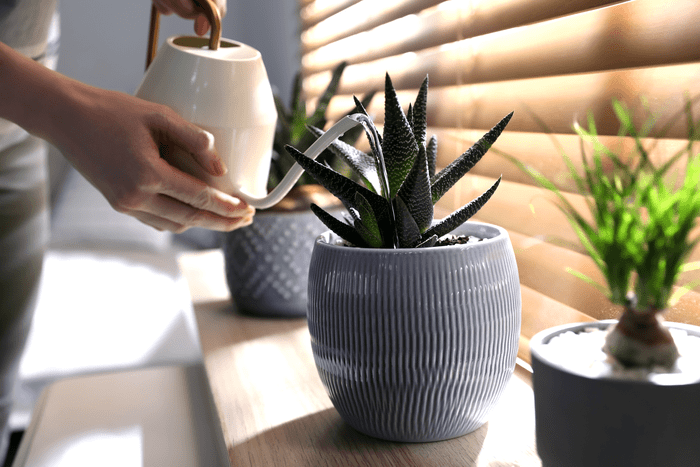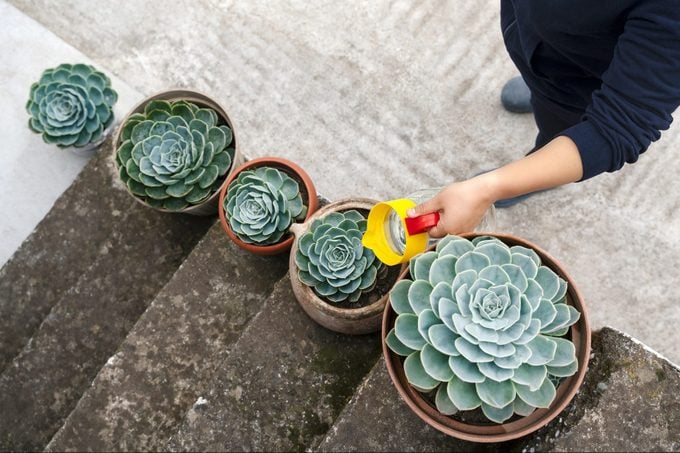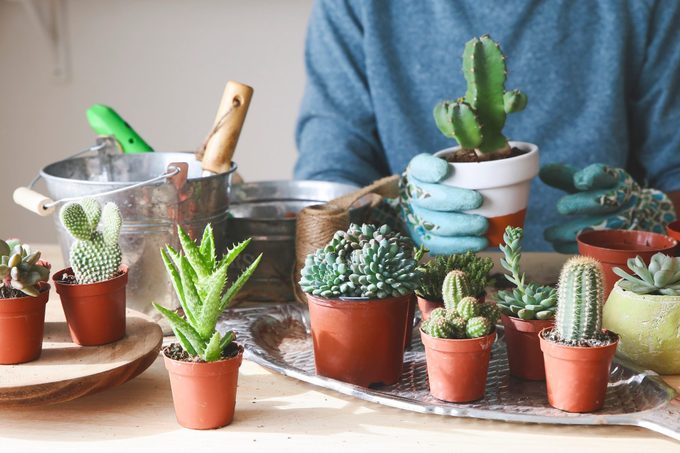How Often to Water Succulents
Updated: Nov. 03, 2022

You need to use a "soak and dry" cycle with these popular plants—here's how.
Do you love the look of a brightly colored kalanchoe or zebra plant? These plants are succulents. There are many eye-catching varieties to grow, from succulents with green spiky shoots to compact, colorful rosettes.
Succulents are great as houseplants; however, it can be hard to figure out how often to water succulents (and what type of water to use). Cactuses and succulents have special built-in water retention systems, including fleshy leaves that trap moisture. This means that jade plants, snake plants, echeveria and aloe vera pull water into the leaves and utilize it until a water source is available again.
Another trick they use to absorb water is their wide root systems, which sit close to the surface, ready to soak up rain. They naturally grow in areas where they receive a downpour followed by long stretches of warm sunshine.
Home gardeners are sometimes hesitant to allow a plant’s soil to become almost bone dry. This can lead to overwatering, which is a top reason for a succulent not surviving. So, it’s important to know how to take care of succulents indoors and outdoors.
How Often to Water Succulents
As a general guide for how often to water succulents, you should check the soil every two weeks. You don’t have to monitor your succulents on a strict schedule, but keep a time frame in mind for every other week to check for dry soil. At different times of the year, these needs may increase or decrease depending on humidity conditions.
With limited sunlight, many succulents go dormant in winter and need less water to thrive. Pay attention to indoor plants near heat vents—they may dry out faster than others.
Most importantly, keep in mind that succulents prefer a “soak and dry” method. This means the soil is thoroughly watered and then allowed to dry out completely before watering again. Check your succulent’s soil by touching the top layer—a succulent in need of watering should feel completely dry.
Another way to tell if your succulent needs water is to look at the leaves. These plants naturally store water in the leaves, which gives them a plump and firm appearance and feel. If the leaves are withered-looking and dull, the water supply has run out and needs to be replenished.
Psst—you’ve been watering indoor plants the wrong way—here’s what to do instead.
How to Water Succulents

It’s important to grow succulents in pots or planters with proper drainage. These plants will quickly become unhappy in moist, poorly draining soils that don’t dry out thoroughly. Be sure there’s a large enough opening in the bottom of the pot to allow excess water to drain. Pour out any water that collects in the saucer under your pot to prevent root rot.
From the Top
Succulents can be watered from above with a bit of guidance. Use a watering can with a spout that allows you to direct the flow of water directly to the top surface of the soil. You can also use a squeeze bottle for top watering. You’ll want to avoid splashing the leaves with excess water, which can pool and stay on the leaves or get trapped in the folds of tightly packed rosettes. For an indoor plant, this spells trouble. Water that stays on the leaves may cause rot.
When it comes to succulents that are grown in the garden or in outdoor planters, you don’t have to worry as much about getting water on the leaves. There’s more airflow outside, which will help the water dry quicker.
From the Bottom
To water succulents from the bottom, you need a tray of water and your plant. Place the succulent in a shallow dish filled with a few inches of water and give it about 10 to 15 minutes to soak up the moisture. This will also encourage the roots to reach down for the water to help stimulate growth.
Bottom watering is also helpful if you find that the potting soil in the container has become tightly compacted. Compressed soil won’t absorb water well from above, and a bottom-watering method will help.
Water Therapy
@passiononplants When your succulents are seriously short of water, you can try watering them this way #plants #plantoftiktok #planttok #plantlover #succulents #succulentlover #watersucculent #fyp ♬ Give It to Me Like – Official Sound Studio
A method of watering called “water therapy” is also a popular practice to water succulents. This process involves submerging the entire potted succulent plant in another container of water for a period of time, and is getting popular on TikTok, as seen in this video by @passiononplants.
Place your succulent in a container that is larger than the planter. Fill the container with water to completely submerge the whole plant.
The plant will start to release tiny air bubbles, which will rise to the surface of the water level and collect on the plant’s leaves. This should take about five minutes. Tap the plant leaves with a skewer to remove any bubbles still being released and remove the plant from the water.
Place the succulent in a well-ventilated area. You will notice a change in the appearance of the leaves as they transform from looking withered to plump as the water rehydrates the plant.
Water therapy is not a regular practice for watering succulents. It can be used occasionally for plants that seem to need a little extra boost. It is also recommended for plants that are in severe need of water or sun damaged. Plants that have been neglected or suffer from a lack of sunlight after being in a shipping box for an extended amount of time can also benefit from water therapy.
Check out the top 10 flashy flowering succulents to grow.
How Much to Water Succulents

Always test the dryness of the soil before giving succulents water, and never water soil that is damp to the touch. If you are unsure of the amount of water, use less rather than more. You can always add more water if necessary!
The condition of the soil and plant appearance will always be reliable indicators of how much to water succulents. Remember that succulents need a stretch of time between watering for thorough drying out of the soil. Follow the “soak and dry” cycle for continued healthy plant growth.
Looking to add new succulents to your collection? Try these pretty pink succulents!




















